Introduction
The growth of population can give impacts to the adequacy and availability such as impact on foodstuffs (FAO/ WPG, 2010). Impact economy and social become one of issues which needs to be given attention and solution (Ministry, 2011). Forest area can also get the impact from the growth of population with various solutions for both negative and positive impact towards forest (Bekkemen et al., 2009). The more pressure towards the land for any kinds of human activities such as habitation, agriculture industry, plantation and forest area diversion for other allocation has caused the forest become narrow (Alkamade et al., 2009).
The existence of private forest in Indonesia is private wood producer resource and crops for human needs in which the benefit has been felt by the society. The farmers who own private forest get good result financially and something which is priceless such as the atmosphere, waterwork and etc (Hillbrad, 2009). The rapidity of population growth and the economy movement causes the increasing of crops demand and woods for various purposes which is not along with the increasing of wood production from forest so that the role of private forest becomes more real in supporting the creation of opportunities for private forest development (Briekman et al., 2011).
The government and society agree to increase the rehabilitation of society’s land in order to support the realization of private forest development dan the increasing of crops (Islam, 2011). The development of private forest is for land rehabilitation, land conservation and increasing crops for society’s welfare (John S. I. Ingram and Hugh L et al., 2013).
The rehabilitation and reforestation project are the starting point in developing private forest area. Yet, after the society fee the economy benefit, they them selves develop it so there are private forest centers (IFPRI,2010).
Seeing from the function of private forest development, they are the form of land management which consider the sustainable yields and conservation but still give opportunities to increase crops, income and farmers’ welfare improvement (KMPG,2010).
The problems occured in the clustering crops systems indicate that private forest area consists of planting area and horticulture plants whereas private forest management is influenced by stands dynamics, horticulture dynamics and labor. As the result, land zoning study with agroforestry system is very important
Materials and Methods
The field data collection through the making of plots is done in private forest area and then analysed with secondary data in which the result is plotted becoming thematic map such as a cluster map, leading sector map and leading center map of basic crops area and leading crops in the form of local crops in Madiun Regency. Analysis concentration and distribution are used to determine the agroforestry clusters while LQ (Location Quotient) is to determine leading sectors in a certain area. The formula is.
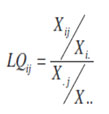
Where,
Xij = Production of crops type J in Madiun
Regency
Xʟ = Total Production of crops in Madiun
Regency
Xj = Total Production crops type J in East
Java
X.. = Total Production of crops in East Java
interpretation of LQ Value
to interpret the anaysis result :
If LQ Value > 1, shows that there is crops product concentration in Madiun sud-district which is relatively compared to the total in Madiun Regency or there is surplus production in Madiun sub-district and that commodity is basic sector in Madiun Regency.
If LQ value = 1, means Madiun sub-district has segment of crops production activity which equals with total segment in Madiun Regency.
If LQ value < 1, means that Madiun sub- district has relatively small segment compared to crops productivity in Madiun Regency or there is crops deficit in Madiun sub-district while software sttela 10.1 is used to make the model.
Results and Discussions
Geographically, private forest area in Madiun Regency is located on 111º BT-112° BT and 7° LS – 8° LS and directly bordered by Madiun City of which the height is about 335 meter above the sea level. Rainfall is about 0-147 mm per day. The map of private forest locations is on figure 1.
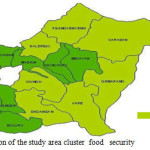 |
Figure 1: Location of the study area cluster food security. |
The concentration analysis is done with LQ method. With this analysis, it can be determined whether this kind of private forest management activity is concentrated in a certain area or spread in some areas. The result of LQ data counting on crops production staple crops group such as corn, cassava, rice, in Madiun Regency is shown on table 1
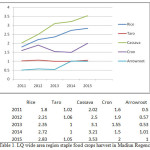 |
Table 1: LQ wide area region staple food crops harvest in Madiun Regency. |
From this analysis, it can be seen if the type of private forest management activity is concentrated in a certain area or spread in some areas. The projection of LQ counts on staple crops such as corn, cassava, and rice in Madiun Reegency from 2011 to 2015.
Determining Leading Sector Dan Priority Sector
With its prioritized development, the crops commodity is expected to increase the amount of the crops. Eventually, it can increase the income of the society and contribute to the economics in Madiun Regency. The figure of variety development of crops in research area is on figure 2.
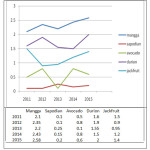 |
Table 2: The diversity of commodities according to district area. |
To determine the best crops commodity in Madiun sub-district, further analysis is used toward LQ value and SI with quality score technique. From 5 commodities of crops recorded in Madiun regency for 5 years from 2011 to 2015, there are 6 best crops if they are developed, they will give big impact towards the increasing of income of the society around the forest. They are manggo and durian those best commodity can be made as one of priorities of crops commodity development in Madiun regency
Model Specification
Sub Model of Private Forest Horticulture
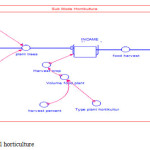 |
Figure 2: Sub Model Horticulture. |
The planting of horticulture plants with material cycle model in the form of planting pattern and planting capital in the research is influenced by the the dimension of planting pattern and planting capital. The planting pattern in this model is intercropping as large as 1 hectare with 3×1 meter row spacing. The material comes out from this system is crops. This crop is influenced by the age of the plant dan the number of the trees on the area. For holticulture plants, the harvest is at the age of 4-11 months based on the age of the plants. The harvest is influenced by the volume of the plant, the percentage of the crops and the type of horticulture plants. The percentage of the crops which is used in this model 100%, and it is done in order to have maximum crops dan can be used for other types which have good opportunity in economics at that time.
Crops volume can be predicted by knowing the total plants and the result per stalk so that the volume of cropping gotten from that crop forest area is at the age of 4-11 months. It is predicted to be influenced by type of the plants and the breadth of the area.
The choosing of option for the model used in making recycle in the option influences the level of income of holticulture private forest farmer at the recycling level and the price per kg which is different. The effective income can be obtained if the price of crops is changed based on the cropping period. The shorter the cropping period, the higher the volume of the crops.
Conclusion
Based on the analysis and model towards income in private forest area, it can be seen that: food sustainability can be increased by using horticulture model in private forest management in some sub districts in Madiun regency especially Madiun sub-district which is still potential. Horticulture plants still dominate be planted in forest area and cassava still becomes the priority in the society. The using of stand cluster model in managing the stand needed in following the trend of wood price in the market. The cropping volume affected by diameter and the height of the trees left at the end of recycling. Besides, the price of wood per cubic also influences the income of the farmers from the crops.
Acknowledgements
The authors would like to thank to Indonesian Directorate General of High Education for research funding granted
References
- Alkemade R., Van Oorschot M., Miles L., Nellemann C., Bakkenes M. and Ten Brink B. GLOBIO3. A Framework to investigate options for reducing global terrestrial biodiversity loss. Ecosystems, 12: 379–380.(2009)
CrossRef - Bakkenes M. and Ten Brink B. A Green. Development mechanism: biodiversity compensation within the globe, regions and biomes. J. Exsplor. 15(4),375-376 (2009)
- Brinkman, H.J. and Hendrix, C.S. Food insecurity and violent conflict: causes, consequences ,and addressing the challenges, world food programme 32 pp.15-17 (2011)
- John S. I. Ingram and Hugh L. Priority research questions for the UK food system. J. Food Sec. 5:624–627. (2013)
- FAO/WFP. The state of food Insecurity in the world : addressing food insecurity in protracte crises, Food and Agriculture Organization of the United Nations (2010)
- Hillebrand E. Poverty growth, and equality over the next 50 years, Food and Agriculture Organization of the United Nations, Economic and Social Development Department. (2009)
- IFPRI. Global hunger index: the challenge of hunger: focus on the crisis of child undernutrition, International Food Policy Research Institute, Bonn; Washington D. C.; Dublin. (2010)
- Islam N. Foreign aid to agriculture. review of facts and analysis, IFPRI (2011)
- KPMG. Certification and biodiversity exploring improvements in the effectiveness of certification schemes on biodiversity.(2012)
- Ministry. Economic affairs, agriculture and innovation grondst of for fennotitie, the hague (2011)
